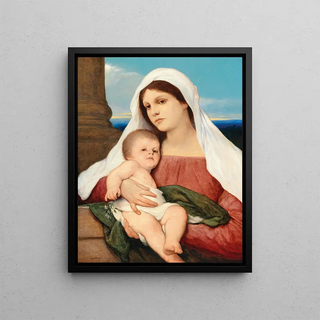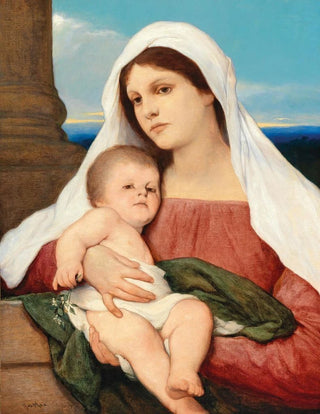Art print | Virgin and Child in an open landscape - Gabriel von Max


View from behind

Frame (optional)
In the fascinating world of art, some works stand out for their ability to evoke deep emotions and transport the viewer into a realm filled with serenity and beauty. "Vierge à l'Enfant dans un paysage ouvert" by Gabriel von Max is one of those creations that capture the very essence of motherhood, while incorporating a natural landscape that seems to breathe peace. This piece, created at the end of the 19th century, reflects an era when art mirrored human feelings, drawing inspiration from elements of nature. The depiction of the Virgin, surrounded by a lush green setting, invites meditative contemplation—a pause amidst the chaos of modern life.
Style and uniqueness of the work
Gabriel von Max's style is characterized by a harmonious blend of realism and a certain form of romanticism. In "Vierge à l'Enfant dans un paysage ouvert," the artist manages to create an atmosphere that is both tangible and spiritual. The delicate features of the Virgin, as well as the gentle child she holds, are rendered with precision that emphasizes the humanity of these sacred figures. The landscape surrounding them, bathed in soft, warm light, enhances this feeling of tranquility. The chosen colors, ranging from soothing greens to celestial blues, evoke a perfect balance between the divine and the earthly. This artwork stands out for its ability to evoke feelings of love, protection, and devotion, while offering a poetic vision of nature.
The artist and his influence
Gabriel von Max, born in 1840 in Prague, is a recognized painter and portraitist whose work is part of the symbolist movement. Influenced by the Romantic current, he developed a personal style that combines mysticism and realism. Max was also passionate about themes of spirituality and human psychology, which is reflected in his works. His ability to capture the soul of the characters he portrayed earned him recognition beyond the borders of his homeland. By addressing religious and mythological subjects, he contributed to enriching the artistic landscape.

Matte finish

View from behind

Frame (optional)
In the fascinating world of art, some works stand out for their ability to evoke deep emotions and transport the viewer into a realm filled with serenity and beauty. "Vierge à l'Enfant dans un paysage ouvert" by Gabriel von Max is one of those creations that capture the very essence of motherhood, while incorporating a natural landscape that seems to breathe peace. This piece, created at the end of the 19th century, reflects an era when art mirrored human feelings, drawing inspiration from elements of nature. The depiction of the Virgin, surrounded by a lush green setting, invites meditative contemplation—a pause amidst the chaos of modern life.
Style and uniqueness of the work
Gabriel von Max's style is characterized by a harmonious blend of realism and a certain form of romanticism. In "Vierge à l'Enfant dans un paysage ouvert," the artist manages to create an atmosphere that is both tangible and spiritual. The delicate features of the Virgin, as well as the gentle child she holds, are rendered with precision that emphasizes the humanity of these sacred figures. The landscape surrounding them, bathed in soft, warm light, enhances this feeling of tranquility. The chosen colors, ranging from soothing greens to celestial blues, evoke a perfect balance between the divine and the earthly. This artwork stands out for its ability to evoke feelings of love, protection, and devotion, while offering a poetic vision of nature.
The artist and his influence
Gabriel von Max, born in 1840 in Prague, is a recognized painter and portraitist whose work is part of the symbolist movement. Influenced by the Romantic current, he developed a personal style that combines mysticism and realism. Max was also passionate about themes of spirituality and human psychology, which is reflected in his works. His ability to capture the soul of the characters he portrayed earned him recognition beyond the borders of his homeland. By addressing religious and mythological subjects, he contributed to enriching the artistic landscape.






